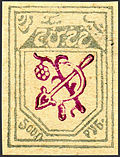Khorezm People's Soviet Republic
| 1920–1924 | |||||||||||||
| Motto: Butun dunyo proletarlari, birlashingiz! "Proletarians of all countries, unite!" | |||||||||||||
 The Khorezm People's Soviet Republic in 1922 | |||||||||||||
| Capital | Khiva | ||||||||||||
| Common languages | Russian, Uzbek, Turkmen, Karakalpak | ||||||||||||
| Religion |
| ||||||||||||
| Government | Socialist republic | ||||||||||||
| Chairman | |||||||||||||
• 1920−1921 (first) | Palvanniyaz Khodja Yusupov | ||||||||||||
• 1924 (last) | Sultan-Kary Dzhumaniyazov | ||||||||||||
| Historical era | Interwar period | ||||||||||||
• Abdication of Sayid Abdullah | 2 February 1920 | ||||||||||||
• Republic established | 26 April 1920 | ||||||||||||
• Part of USSR | 27 October 1924 | ||||||||||||
| |||||||||||||
| Today part of | Turkmenistan Uzbekistan Kazakhstan | ||||||||||||

The Khorezm People's Soviet Republic (Uzbek: Хоразм Халқ Совет Республикаси, romanized: Xorazm Xalq Sovet Respublikasi; Russian: Хорезмская Народная Советская Республика, tr. Khorezmskaya Narodnaya Sovetskaya Respublika) was the state created as the successor to the Khanate of Khiva in February 1920, when the Khan abdicated in response to pressure. It was officially declared by the First Khorezm Kurultay (Assembly) on 26 April 1920. On 20 October 1923, it was transformed into the Khorezm Socialist Soviet Republic (Russian: Хорезмская ССР, tr. Khorezmskaya SSR).[1]


On 27 October 1924 the Khorezm SSR was divided between the Uzbek and Turkmen SSRs and the Karakalpak Autonomous Oblast as part of the delimitation of Central Asia according to nationalities.[2] The history of this short-lived republic remains murky and the way its government functioned is not largely clear. The government officials fervently opposed the delimitation plans of the Khorezmian Republic (which had to be carried out under Stalin’s orders) but in the end they were forced to concede.
Politics[edit]
Political leaders[edit]
| Name | Took office | Left office | Party | Notes | |
|---|---|---|---|---|---|
| Chairman of the Revolutionary Committee | |||||
| Mulla Dzhumaniyaz Sultanmuradov | 2 February 1920 | 26 April 1920 | Communist Party of Khorezm | ||
| Chairmen of the Presidium of the Assembly (Kurultoy) of People's Representatives | |||||
| Palvanniyaz Khodja Yusupov | 26 April 1920 | 6 March 1921 | Communist Party of Khorezm | ||
| Dzhabbarbergen Kuchkarov | 6 March 1921 | 15 May 1921 | Communist Party of Khorezm | Continued as supreme authority to 23 May 1921 | |
| Khudaybergen Divanov | 15 May 1921 | 23 May 1921 | Communist Party of Khorezm | ||
| Chairmen of the Presidium of the Central Executive Committee | |||||
| Madrakhim Allabergenov | 23 May 1921 | 5 September 1921 | Communist Party of Khorezm | ||
| Mulla Ata-Maksum Madrakhimov | 5 September 1921 | 27 November 1921 | Communist Party of Khorezm | ||
| Yangibay Muradov | 27 November 1921 | 23 July 1922 | Communist Party of Khorezm | ||
| Abdulla Khodzhayev "Khadzhi Baba" | 23 July 1922 | 20 October 1922 | Communist Party of Khorezm | 1st term | |
| Atadzhan Safayev | 20 October 1922 | 26 March 1923 | Communist Party of Khorezm | ||
| Abdulla Khodzhayev "Khadzhi Baba" | March 1923 | 20 October 1923 | Communist Party of Khorezm | 2nd term | |
| Karim Safayev | 20 October 1923 | 26 March 1924 | Communist Party of Khorezm | ||
| Mukhamed Abdusalyamov | 17 January 1924 | 19 February 1924 | Communist Party of Khorezm | ||
| Sultan-Kary Dzhumaniyazov | 26 March 1924 | 17 September 1924 | Communist Party of Khorezm | 1st term | |
| Nedirbay Aytakov | 17 September 1924 | 27 October 1924 | Communist Party of Khorezm | ||
| Sultan-Kary Dzhumaniyazov | October 1924 | 23 November 1924 | Communist Party of Khorezm | 2nd term | |
Geography[edit]
The Khorezm People's National Republic bordered on the Turkestan Autonomous Soviet Socialist Republic to the north and to the south, and on the Bukharan People's Soviet Republic to the east. Its western border was a rough continuation of the western coast of Aral Sea, bordering on what was then the Kirghiz ASSR (today's western Kazakhstan). It had an area of 62,200 km2 (24,000 sq mi) and a population of more than 600,000 people, mainly Uzbeks (62.5%), Turkmens (28.6%), Kazakhs (3.5%), and Karakalpaks (3.0%). Its capital was Khiva.[1]
See also[edit]
References[edit]
- ^ a b Khorezm People's Soviet Republic: Big Soviet Encyclopedia on-line edition. (in Russian)
- ^ Погорельский И.В. История Хивинской революции и Хорезмской народной советской республики 1917–1924 гг., Ленинград: Изд-во ЛГУ, 1984
External links[edit]
 Media related to Khorezm People's Soviet Republic at Wikimedia Commons
Media related to Khorezm People's Soviet Republic at Wikimedia Commons- History of the Khorezm People's Soviet Republic: The first Khorezm Kurultay
- History of the Khorezm People's Soviet Republic: Djunaid Khan's revolt
- 1920 establishments in Russia
- 1924 disestablishments in the Soviet Union
- Geographic history of Uzbekistan
- 20th century in Turkmenistan
- Early Soviet republics
- Former socialist republics
- States and territories established in 1920
- States and territories disestablished in 1924
- Soviet Central Asia
- Former countries of the interwar period
- Post–Russian Empire states
- Khwarazm




